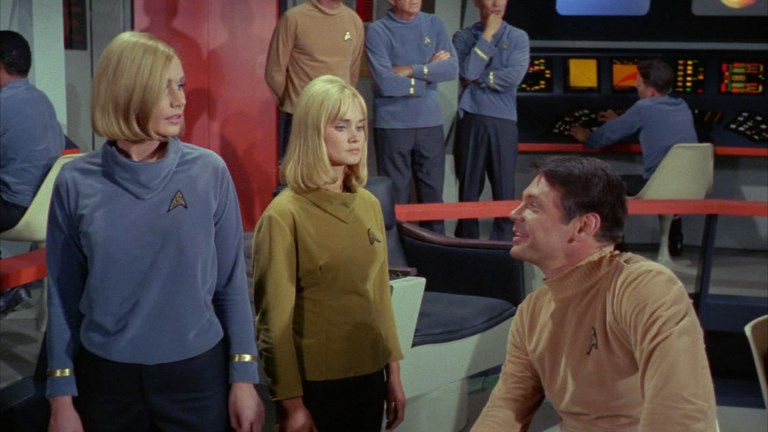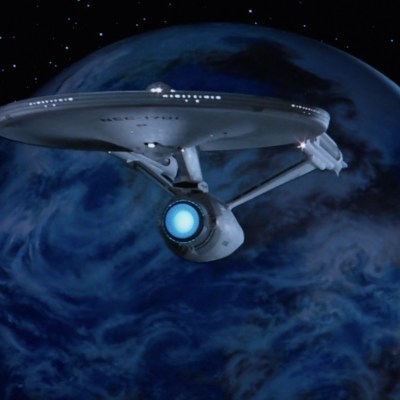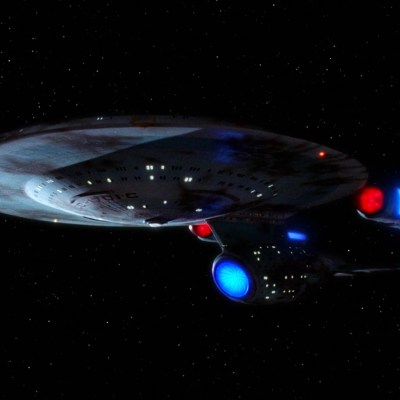Star Trek: The Original Series Needs A Real Origin Story
The first year of Kirk, Spock, and Bones' mission on the Enterprise has never officially been explored in Star Trek canon.

When Star Trek: Strange New Worlds eventually debuts on CBS All Access and gives us the further adventures of Captain Pike, Spock, and Number One aboard the USS Enterprise NCC-1701, another gap in the Star Trek timeline will be fully explored. And yet, this gap isn’t the weirdest missing piece of Trek history. Other than one episode of The Original Series, we have almost zero on-screen canonical record of adventures that may have occurred for some — or all — of the year 2265, the first year of Kirk, Spock, and McCoy’s five year mission on the Enterprise. In essence, Star Trek: Year One, does not exist. But, could it happen now?
Back when The Original Series first aired, the notion of exactly when it was set was kept somewhat vague. In fact, according to The Making of Star Trek (1968), in Roddenberry’s earliest pitches to networks, he specifically noted that the setting could have been in the 1990s or 22nd century. His original pitch read: “The time could be 1995 or even 2995 — close enough to our times for our continuing cast to be people like us, but far enough in the future for galaxy travel to be fully established.”
While it’s true that Roddenberry eventually settled on the 23rd Century as being the “real” setting for the series, some episodes (notably “Space Seed”) imply the series is only set two hundred years in the future, meaning the late 22nd century or the early 23rd (Khan says he has been sleeping for “two centuries” since the late 1990s).
In 1980, a book called Star Trek: Spaceflight Chronology — published in connection with the first Star Trek roleplaying game — claimed the future history of Trek happened in the very early 23rd century, meaning the five-year-mission of the Enterprise, at that point, was from 2207 to 2212. But, two years later, Star Trek II: The Wrath of Khan changed all that when the words “In the 23rd century…” filled the screen, and it was later established that The Wrath of Khan took place in 2285 (the Romulan Ale Bones brings Kirk was vintage 2283). From that point on, the era of The Original Series began in the 2260s (TOS) and spanned to the 2290s (The Undiscovered Country).
So, why is the first year of TOS missing? Well, the actual start date of Kirk’s five-year mission has changed twice. First, the Spaceflight Chronology established it as 2207, but then in 1993, with the publication of The Star Trek Chronology re-established it as 2264. Authors Denise Okuda and Michael Okuda (who worked as designers on Trek throughout the ‘90s and early ‘00s) picked 2264 because the idea was that The Next Generation began in 2364, exactly 100 years later, and that 2264 would be roughly exactly 300 years from the point Star Trek first began filming in 1964.
However, dialogue in the Voyager episode “Q2” mentioned Kirk’s five-year mission ended in 2270, which means it (retroactively) began in 2265, not 2264. So, 2265 is when the “official” canon settled on the actual start of TOS (yes, Voyager saved TOS chronology!).
This is where things get interesting.
In terms of this official canon — and what Roddenberry intended — the only episode that happens in 2265 (or 2264 in old canon) is “Where No Man Has Gone Before.” In case you’ve forgotten, this episode was the second pilot of Star Trek (after “The Cage”) and the one where Spock wears a gold command uniform, Sulu is wearing blue, and everybody has uniforms that look more like husky sweaters than the slick ‘60s chic of the rest of the show. In The Making of Star Trek, Roddenberry makes it clear that the rest of the series is meant to occur well after this pilot episode, which explains why the crewmembers are all fairly familiar with each other in literally all the other episodes.
When you watch “Where No Man Has Gone Before” – again, the only canonical story set in 2265 — it’s very clear the Enterprise we see here is very different from the Enterprise we see in the rest of the series. Not only are various crew members not in their familiar roles (Sulu isn’t the helmsman, he works in “astrosciences”) but also many of the most famous crew members are missing: Specifically, Uhura and Bones. In canon, we have no idea what it was like when Uhura, Bones, Scotty, Kirk, or Sulu first came on board the ship. In fact, until the 2019 Discovery episode “Q&A”, we also had no idea what this was like for Spock, either.
Outside of “Where No Man Has Gone Before,” we’re not sure what happened during 2265, other than the fact that Kirk flirted with Dr. Helen Noel at a Christmas party because he and Helen talk about this a year later in 2266 during “Dagger of the Mind.” And, funnily enough, if Star Trek years work the way ours do, this means the only 2265 event referenced in TOS would have happened at the very end of that year. The rest of the year is a complete mystery.
At the end of “Where No Man Has Gone Before,” Gary Mitchell has died after having transformed into a ESP-wielding space deity. Spock admits to Kirk that Mitchell’s death affected him. “I felt for him, too,” Spock says. And then, the series, basically, fast-forwards to an entire year later. “The Man Trap,” “The Corbomite Maneuver,” and the rest of the first season clearly happens after a lot of time has passed. But what was the Enterprise like when Mitchell was still alive and Spock didn’t “feel” for him? Did “Where No Man Has Gone Before” happen right at the start of 2265 or toward the middle? Near the end? It’s the oldest period of Star Trek and we still know almost nothing about it.
As far as the actual events of Kirk’s five year mission are concerned, not counting “Where No Man Has Gone Before,” all the episodes (and The Animated Series) happen between 2266-2270. Most fans and scholars place TOS from 2266-2268-ish and The Animated Series from 2269-2270 (though there is some overlap between TOS and TAS).
The other gaps in the Kirk era have been explored outside of official canon. IDW comics have tackled the idea of the “fifth season” of Star Trek, most recently with the miniseries Star Trek: Year Five. Back in 1989, J.M. Dillard published the novel Star Trek: The Lost Years, which would have filled in the time between the end of TOS and the beginning of Star Trek: The Motion Picture.
However, there’s been far less attention paid to the first year, 2265. In 1985, DC Comics published a special issue about “The First Mission,” in which the absence of Bones in “Where No Man Has Gone Before” was hastily explained. However, this story took place in the form of a “flashback” during what was then the regular continuity of DC Comics’ Star Trek timeline: At that point in the “present,” Kirk was in command of the Excelsior, the Enterprise had not been rebuilt, and Spock had his own ship called the USS Surak. The point is, this Year 1 origin story was the flashback to what is now, at best, an alternate timeline.
Somewhat more significantly, in 1986, Pocket Books published the novel Enterprise: The First Adventure, written by legendary SF author Vonda M. McIntyre. This book tackled a variety of tricky canon issues including Chekov’s status during the first season (he worked in a different part of the ship) Spock’s random emotionalism (including a Vulcan circus performer), and the fact that almost nobody liked Kirk at first. Back in the ‘80s, McIntyre’s Star Trek books were among the best, mostly because her writing tended to be cited as pseudo-canon even when it technically wasn’t.
Case-in-point, her 1981 Trek novel, The Entropy Effect, gave Sulu and Uhura the first names Hikaru and Nyota, both of which stuck. This isn’t to say Enterprise: The First Adventure actually “counts” as part of canon, or that the first adventure of the Enterprise under Kirk involved housing a group of traveling entertainers, but McIntyre’s books had a way of sticking into the way fans talked about canon back in the day, especially when it came to missing things, like characters’ names.
Speaking of Uhura’s first name, the most famous “Year 1” Star Trek story of them all is the 2009 movie Star Trek. But, as most fans are probably aware, the J.J. Abrams Star Trek film creates, and takes place, in an alternate universe, in which the crew of the original Enterprise meets in an entirely different way, and the tech of the 23rd century is profoundly influenced by a time-traveling Romulan ship from the future (got all that?).
The so-called “Kelvin Timeline” actually bumped-up the earliest adventures of Captain Kirk by several years. In its own timeline, the bulk of Star Trek 2009 occurs in 2258. In the Prime Timeline, this is six years earlier than when Kirk originally took command of the Enterprise.
In fairness, the Abramsverse accounts for this by having Kirk go from Cadet to Captain in like two hours, thanks to a series of bizarre circumstances, but still, if we were only concerned about the Kelvin timeline, then the “Year 1” moment of Star Trek would be very clearly established.
The 2009 Star Trek can be debated from a variety of different angles, but the one thing it makes pretty plain is that it is not the “actual” origin story of the TOS crew coming together, but instead, that story “retold” in an alternate universe. This is pretty weird relative to other fandoms: Star Trek 2009 would be like if the Alien–prequel Prometheus went out of its way to turn to the camera and say “this is a prequel, but one that takes place in a different dimension, and also, the chronology doesn’t work. Oops.”
So, the 2258 of Star Trek 2009 isn’t the “right” 2258, and none of what happens in the “present” of those films is connected to TOS, Discovery, or the upcoming Strange New Worlds. In fact, the year 2258 is likely the start of Strange New Worlds.The final scenes in Discovery Season 2 happen in 2258, in which the crew of the Enterprise (and Ash Tyler) are all debriefed at Starfleet Command. This means Strange New Worlds will likely happen between 2258 and 2263 because that would be another Five-Year-Mission for Pike. This brings us very close to 2265, the real first year of Kirk’s command of the Enterprise.
2265 is missing. It’s arguably the most formative era in all of Star Trek, and the period which establishes the classic characters in the roles that define the rest of the franchise. If Strange New Worlds shows us the entire journey of Pike’s Enterprise, it could, in theory, have an entire season set after Pike hands the keys to Kirk. The first year of The Original Series could become the final season of Strange New Worlds. And that means everyone who has been waiting for a new Captain Kirk could finally get their wish.
Strange New Worlds is expected to start airing some time in 2021 or 2022.


